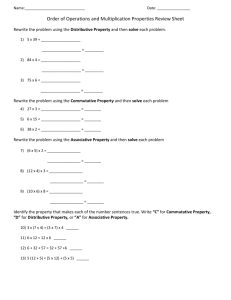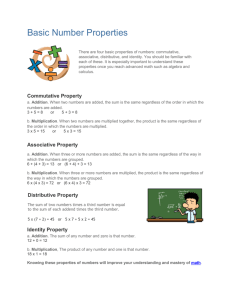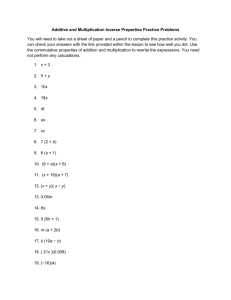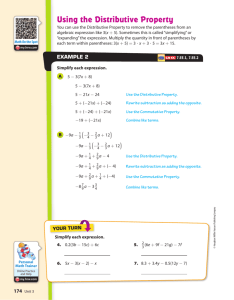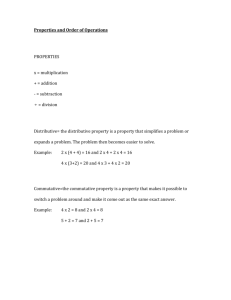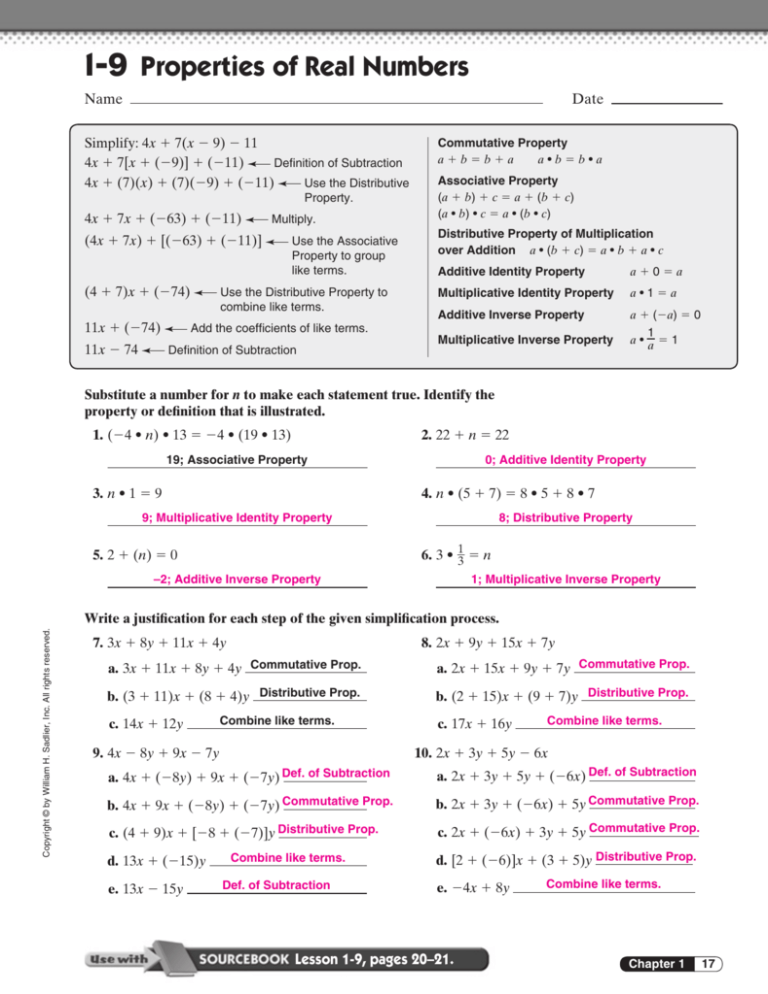
1-9 Properties of Real Numbers
Name
Date
Simplify: 4x 7(x 9) 11
Definition of Subtraction
4x 7[x (9)] (11)
4x (7)(x) (7)(9) (11)
Use the Distributive
Property.
4x 7x (63) (11)
Multiply.
(4x 7x) [(63) (11)]
(4 7)x (74)
11x (74)
11x 74
Use the Associative
Property to group
like terms.
Use the Distributive Property to
combine like terms.
Add the coefficients of like terms.
Definition of Subtraction
Commutative Property
abba
a•bb•a
Associative Property
(a b) c a (b c)
(a • b) • c a • (b • c)
Distributive Property of Multiplication
over Addition a • (b c) a • b a • c
Additive Identity Property
a0a
Multiplicative Identity Property
a•1a
Additive Inverse Property
a (a) 0
1
a•a1
Multiplicative Inverse Property
Substitute a number for n to make each statement true. Identify the
property or definition that is illustrated.
1. (4 • n) • 13 4 • (19 • 13)
2. 22 n 22
0; Additive Identity Property
19; Associative Property
3. n • 1 9
4. n • (5 7) 8 • 5 8 • 7
9; Multiplicative Identity Property
8; Distributive Property
1
5. 2 (n) 0
6. 3 • 3 n
–2; Additive Inverse Property
1; Multiplicative Inverse Property
Copyright © by William H. Sadlier, Inc. All rights reserved.
Write a justification for each step of the given simplification process.
7. 3x 8y 11x 4y
8. 2x 9y 15x 7y
a. 3x 11x 8y 4y Commutative Prop.
a. 2x 15x 9y 7y Commutative Prop.
b. (3 11)x (8 4)y Distributive Prop.
b. (2 15)x (9 7)y Distributive Prop.
c. 14x 12y
c. 17x 16y
Combine like terms.
9. 4x 8y 9x 7y
Combine like terms.
10. 2x 3y 5y 6x
a. 4x (8y) 9x (7y) Def. of Subtraction
a. 2x 3y 5y (6x) Def. of Subtraction
b. 4x 9x (8y) (7y) Commutative Prop.
b. 2x 3y (6x) 5y Commutative Prop.
c. (4 9)x [8 (7)]y Distributive Prop.
c. 2x (6x) 3y 5y Commutative Prop.
d. 13x (15)y
d. [2 (6)]x (3 5)y Distributive Prop.
e. 13x 15y
Combine like terms.
Def. of Subtraction
e. 4x 8y
Lesson 1-9, pages 20–21.
Combine like terms.
Chapter 1
17
For More Practice Go To:
and justifications may vary.
Simplify each expression. Write a justification for each step. Steps
Check students’ answers.
11. 11t 4(2t 9)
12. 20d 6(3d 2)
13. 15a 3(4 5a)
15a ⴙ 12 ⴙ 15a; Distributive Prop.
15a ⴙ 15a ⴙ 12; Commutative Prop.
(15a ⴙ 15a) ⴙ 12; Associative Prop.
30a ⴙ 12; Add to combine like terms
30a ⴙ 12
15. x (1 3x)
x ⴙ (–1)[1 ⴙ (ⴚ3x)]; Def. of subtraction
x ⴙ (–1)(1) ⴙ (ⴚ1)(ⴚ3x); Distributive Prop.
x ⴙ (–1) ⴙ 3x; Multiply
x ⴙ 3x ⴙ (ⴚ1); Commutative Prop.
4x ⴙ (ⴚ1); combine like terms
4x ⴚ 1; Def. of subtraction
17. 4[3c 9 4c] 8
20d ⴙ (ⴚ6)[3d ⴙ (ⴚ2)]; Def. of subtraction
20d ⴙ (ⴚ18d) ⴙ 12; Distributive Prop.
2d ⴙ 12; combine like terms
2d ⴙ 12
14. 13b 4(5 7b)
13b ⴙ 20 ⴙ 28b; Distributive Prop.
13b ⴙ 28b ⴙ 20; Commutative Prop.
41b ⴙ 20; Add coefficients of like terms
41b ⴙ 20
16. 2v (3 4v)
2v ⴙ (ⴚ1)[3 ⴙ (ⴚ4v)]; Def. of subtraction
2v ⴙ (ⴚ3) ⴙ 4v; Distributive Prop. and Multiply
2v ⴙ 4v ⴙ (ⴚ3); Commutative Prop.
6v ⴙ (ⴚ3); add coefficients of like terms
6v ⴚ 3; Def. of subtraction
18. 5[2d 3 4d] 2
4[3c ⴙ 9 ⴙ (ⴚ4c)] ⴙ 8; Def. of subtraction
[12c ⴙ 36 ⴙ (ⴚ16c)] ⴙ 8; Distributive Prop.
[12c ⴙ (ⴚ16c) ⴙ 36] ⴙ 8; Commutative Prop.
[12c ⴙ (ⴚ16c)] ⴙ [36 ⴙ 8]; Associative Prop.
ⴚ4c ⴙ 44; combine like terms
5[2d ⴙ 3 ⴙ (ⴚ4d)] ⴙ 2; Def. of subtraction
[10d ⴙ 15 ⴙ (ⴚ20d)] ⴙ 2; Distributive Prop.
[10d ⴙ (ⴚ20d) ⴙ 15] ⴙ 2; Commutative Prop.
[10d ⴙ (ⴚ20d)] ⴙ [15 ⴙ 2]; Associative Prop.
ⴚ10d ⴙ 17; combine like terms
19. Is there a Commutative Property for
subtraction or division? Give an example for
each. Then find an exception for each.
20. A new operation ♣ is defined as
a ♣ b a b ab. For example,
3 ♣ 2 3 2 3(2) 5 6 11. Is the
operation ♣ commutative? Give an example.
No; possible answers: 9 ⴚ 2 苷 2 ⴚ 9 and
8 ⴜ 2 苷 2 ⴜ 8; exceptions: if the numbers are
the same, a ⴚ a ⴝ a ⴚ a and a ⴜ a ⴝ a ⴜ a
Yes; a ⴙ b ⴙ ab ⴝ b ⴙ a ⴙ ba because
addition and multiplication are commutative.
So a ♣ b ⴝ b ♣ a. 3 ♣ 2 ⴝ 3 ⴙ 2 ⴙ 3(2) ⴝ 11
and 2 ♣ 3 ⴝ 2 ⴙ 3 ⴙ 2(3) ⴝ 11.
21. Use examples to explain why the Associative Property does not work
for subtraction and division. Give the exceptions.
Possible response: 9 ⴚ (2 ⴚ 3) 苷 (9 ⴚ 2) ⴚ 3 because 10 苷 4; subtraction is associative only
when the last number is 0: (a ⴚ b) ⴚ 0 ⴝ a ⴚ (b ⴚ 0); 8 ⴜ (2 ⴜ 2) 苷 (8 ⴜ 2) ⴜ 2 because 8 苷 2;
division is associative only when the last number is 1: (a ⴜ b) ⴜ 1 ⴝ a ⴜ (b ⴜ 1).
18
Chapter 1
Copyright © by William H. Sadlier, Inc. All rights reserved.
11t ⴙ (ⴚ4)[2t ⴙ (ⴚ9)]; Def. of Subtraction
11t ⴙ (ⴚ4)(2t) ⴙ (ⴚ4)(ⴚ9); Distributive Prop.
11t ⴙ (ⴚ8)t ⴙ 36; Multiply.
[11t ⴙ (ⴚ8)t] ⴙ 36; Associative Prop.
[11ⴙ (ⴚ8)]t ⴙ 36; Distributive Prop.
3t ⴙ 36; Add coefficients.


